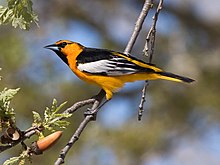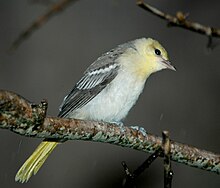Bullock's oriole
| Bullock's oriole | |
|---|---|
 |
|
| Male | |
 |
|
| Female | |
| Scientific classification | |
| Kingdom: | Animalia |
| Phylum: | Chordata |
| Class: | Aves |
| Order: | Passeriformes |
| Family: | Icteridae |
| Genus: | Icterus |
| Species: | I. bullockii |
| Binomial name | |
|
Icterus bullockii (Swainson, 1827) |
|
 |
|
| Range of I. bullockii Breeding range Wintering range | |
The Bullock's oriole (Icterus bullockii) is a small New World blackbird. At one time, this species and the Baltimore oriole were considered to be a single species, the northern oriole. This bird was named after William Bullock, an English amateur naturalist.
Bullock's orioles are sexually dimorphic, with males being more brightly colored than females. In addition, adult males tend to be slightly larger and heavier than females. In general, adults range in mass from 29 to 43 g (1.0 to 1.5 oz). Adults have a pointed bill with a straight culmen. In adult males, the tail is long, square, and jet black. All exposed skin is black, as are the claws and bill, though the base of the lower mandible lightens to bluish-gray.
Adult males are characterized by strongly contrasting orange and black plumage, a black throat patch and a white wing bar. The underparts, breast, and face are orange or yellow; by contrast, the back, wings, and tail are black. A black line extends from each eye to the black crown. The wing coverts (feathers not directly used in flight) are fringed white, forming a wing patch. Although the tail is mostly black, the outermost three or four retrices (flight feathers) are tipped orange, forming a T shape. Adult females, by contrast, have gray-brown upperparts, duller yellow on the breast and underparts, and an olive crown. Some females may also have a dark throat patch, similar (but less extensive) to the one found in adult males; in all cases females lack the black eye-line present in adult males. It is hypothesized that females with throat patches are older individuals.
Following the general pattern observed among icterids, the overall plumage pattern seen in immature male Bullock's orioles closely resembles that seen in adult females. Juveniles resemble adult females but have darker wings, fresh wing coverts, and a pink or whitish bill. Sexual dimorphism is not obvious in juveniles.
Bullock's orioles are seasonally monogamous. The breeding season typically lasts from May until July. The exact timing of the beginning of the breeding season tends to vary geographically: in general, breeding begins later in the northernmost and westernmost portions of its geographic range. Mated pairs of Bullock's orioles cooperate to weave deep, pendant baskets in which are deposited between three and six eggs, though females tend to do much of the work. The nest is woven of plant fibers, primarily bark and fine grass fiber, though animal hair is also commonly used. The nest is lined with down, hair, and moss.
...
Wikipedia

